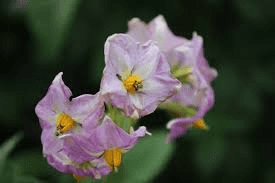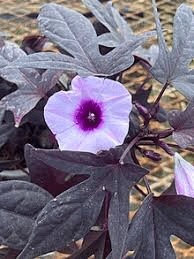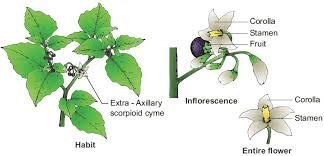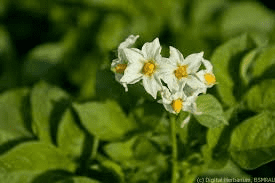The potato inflorescence is the flowering part of the potato plant (Solanum tuberosum) and plays a key role in the plant’s reproductive process. While potatoes are primarily grown for their tubers, the flowers and inflorescences are important for understanding the plant’s biology, genetic diversity, and breeding.
The potato inflorescence is a cluster of flowers that form at the end of the plant’s stems. These inflorescences typically emerge after the plant has established its foliage and begun tuber formation. Each inflorescence can contain multiple flowers, ranging from a few to several dozen, depending on the variety and growing conditions. The arrangement of flowers in an inflorescence is usually a cyme, where the central flower opens first, followed by the surrounding flowers.
Potato flowers are generally small, star-shaped, and can vary in color, including white, pink, purple, and blue, depending on the potato variety. The flower has five petals fused at the base, forming a corolla, and five prominent stamens with yellow anthers surrounding a central pistil. The color and morphology of the flowers can be used to identify different potato cultivars and assess genetic diversity within potato populations.
The primary purpose of the inflorescence and flowers is sexual reproduction. Potato plants are typically self-pollinating, meaning that pollen from the same plant can fertilize the ovules. However, cross-pollination between different plants can also occur, facilitated by wind or pollinators such as bees. Successful pollination leads to the development of small, green, berry-like fruits that contain seeds. These seeds can be used for breeding and developing new potato varieties, although they are not commonly used for commercial potato propagation.
The inflorescence and flowering stage of the potato plant provide important information about the plant’s growth and development. Flowering usually occurs when the plant has accumulated sufficient energy and resources, indicating a healthy and well-nourished plant. The timing of flowering can also be influenced by environmental factors such as day length, temperature, and soil conditions. In some potato varieties, flowering may be more pronounced, while in others, it may be sparse or absent, depending on the genetic makeup and growing environment.
For potato breeders, the inflorescence and flowers are crucial for developing new potato varieties with desirable traits such as disease resistance, improved yield, and enhanced nutritional content. By cross-pollinating different potato plants and selecting for specific traits, breeders can create new cultivars that meet the needs of farmers and consumers. The genetic diversity found in potato flowers and seeds contributes to the overall resilience and adaptability of potato crops.
Despite their importance for reproduction and breeding, the flowers and inflorescence of the potato plant are generally not the focus of commercial potato production. The primary goal of potato farming is to produce tubers, which are propagated vegetatively from seed potatoes rather than from seeds produced by flowers. As a result, flowering and fruiting are often considered secondary aspects of potato cultivation.
In summary, the potato inflorescence is a cluster of flowers that plays a vital role in the reproductive process of the potato plant. These flowers facilitate sexual reproduction, contributing to genetic diversity and the development of new potato varieties. Understanding the biology and significance of potato inflorescences is important for plant breeders and researchers, although the primary focus of potato cultivation remains the production of tubers. The presence and health of potato flowers can provide valuable insights into the plant’s growth and development, contributing to more effective management and breeding practices.
The Economic Importance and Uses of Potato Inflorescence

1. Breeding Programs: Potato inflorescence is essential in breeding programs to develop new potato varieties with desired traits such as disease resistance and higher yields.
2. Pollination Studies: Research on potato inflorescence helps understand pollination mechanisms, improving pollination efficiency and crop production.
3. Seed Production: Inflorescences are involved in the production of true potato seeds, which are used for breeding and research.
4. Genetic Research: Potato flowers are used in genetic studies to understand inheritance patterns and develop genetically modified crops.
5. Disease Resistance: Studying potato inflorescence helps identify disease-resistant traits, aiding in the development of resilient potato varieties.
6. Biodiversity Conservation: Potato inflorescence plays a role in conserving genetic diversity within potato species, which is crucial for sustainable agriculture.
7. Pharmaceutical Research: Compounds found in potato flowers are studied for their potential medicinal properties.
8. Nutrient Analysis: Analysis of potato inflorescence can provide insights into the nutrient content of the plants, helping optimize fertilization practices.
9. Educational Purposes: Potato inflorescence is used in educational settings to teach students about plant reproduction and flower anatomy.
10. Pest Control: Potato flowers can attract beneficial insects that help control pest populations, reducing the need for chemical pesticides.
11. Floral Arrangement: Potato flowers can be used in floral arrangements and decorations, adding aesthetic value.
12. Pollinator Attraction: Potato inflorescence attracts pollinators such as bees, which are essential for the pollination of many crops.
13. Ecological Studies: Potato flowers are studied in ecological research to understand plant-pollinator interactions and ecosystem dynamics.
14. Crop Improvement: Research on potato inflorescence contributes to the development of high-yielding and stress-tolerant potato varieties.
15. Aromatic Compounds: Potato flowers contain aromatic compounds that are studied for their potential use in fragrances and flavorings.
16. Seed Banking: Inflorescence is important for seed banking efforts to preserve genetic material for future breeding and conservation.
17. Cultural Significance: In some cultures, potato flowers have traditional and symbolic meanings, contributing to cultural heritage.
18. Botanical Research: Potato inflorescence is used in botanical research to study flower development and physiology.
Read Also: Recommended Number of Ruminant Animals per Housing Unit for Fattening
The Products and By-products That Can Be Derived From Potato Inflorescence

1. True Potato Seeds: Potato flowers produce true seeds that are used for breeding and research purposes.
2. Aromatic Extracts: Aromatic compounds from potato flowers can be extracted for use in fragrances and flavorings.
3. Medicinal Compounds: Bioactive compounds found in potato flowers are studied for their potential medicinal applications.
4. Natural Pesticides: Compounds from potato flowers can be used to develop natural pesticides for pest control.
5. Pollinator Attractants: Extracts from potato flowers can be used to create products that attract pollinators to crops.
6. Botanical Dyes: Potato flowers can be used to produce natural dyes for textile and craft industries.
7. Floral Arrangements: Fresh or dried potato flowers can be used in floral arrangements and decorations.
8. Plant Growth Regulators: Extracts from potato flowers may be used to develop plant growth regulators that enhance crop production.
9. Essential Oils: Potato flowers can be processed to extract essential oils for use in aromatherapy and cosmetics.
10. Nutrient Supplements: Nutrient-rich extracts from potato flowers can be used to create supplements for agricultural use.
11. Biofertilizers: Extracts from potato flowers can be used to produce biofertilizers that promote plant growth.
12. Research Materials: Potato flowers provide materials for genetic, botanical, and ecological research.
13. Traditional Medicines: In some cultures, potato flowers are used in traditional medicine for various treatments.
14. Decorative Crafts: Dried potato flowers can be used in making decorative crafts and art pieces.
15. Educational Tools: Potato flowers are used as teaching aids in educational institutions to study plant biology.
16. Seed Banks: Inflorescence is important for preserving genetic material in seed banks for future breeding and conservation efforts.
17. Biodiversity Studies: Potato flowers are studied to understand and conserve plant biodiversity in different ecosystems.
Read Also: Gray Leaf Spot (Stemphylium spp) – Symptoms and Damage Control
Frequently Asked Questions (FAQ’s) About Potato Inflorescence

1. What is potato inflorescence?
Potato inflorescence refers to the cluster of flowers on the potato plant, typically found at the top of the plant’s stem.
2. How does potato inflorescence contribute to breeding programs?
Potato inflorescence is used in breeding programs to develop new potato varieties with desirable traits such as disease resistance and higher yields.
3. Are potato flowers edible?
No, potato flowers are not edible and contain toxic compounds.
4. How do potato flowers attract pollinators?
Potato flowers produce nectar and have colorful petals that attract pollinators like bees.
5. What is the significance of true potato seeds?
True potato seeds are used for breeding and research, providing genetic diversity and enabling the development of improved potato varieties.
6. Can potato flowers be used in floral arrangements?
Yes, potato flowers can be used in floral arrangements and decorations for their aesthetic appeal.
7. What role do potato flowers play in disease resistance research?
Studying potato flowers helps identify disease-resistant traits, aiding in the development of resilient potato varieties.
8. How are potato flowers used in pharmaceutical research?
Compounds found in potato flowers are studied for their potential medicinal properties and applications.
9. How do potato flowers contribute to biodiversity conservation?
Potato inflorescence plays a role in conserving genetic diversity within potato species, which is crucial for sustainable agriculture.
10. What are the potential uses of aromatic compounds from potato flowers?
Aromatic compounds from potato flowers can be used in fragrances, flavorings, and natural pest repellents.
Read Also: 4 Steps to help an Orange Tree Produce Sweet Oranges






